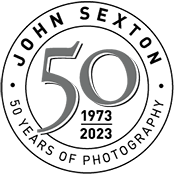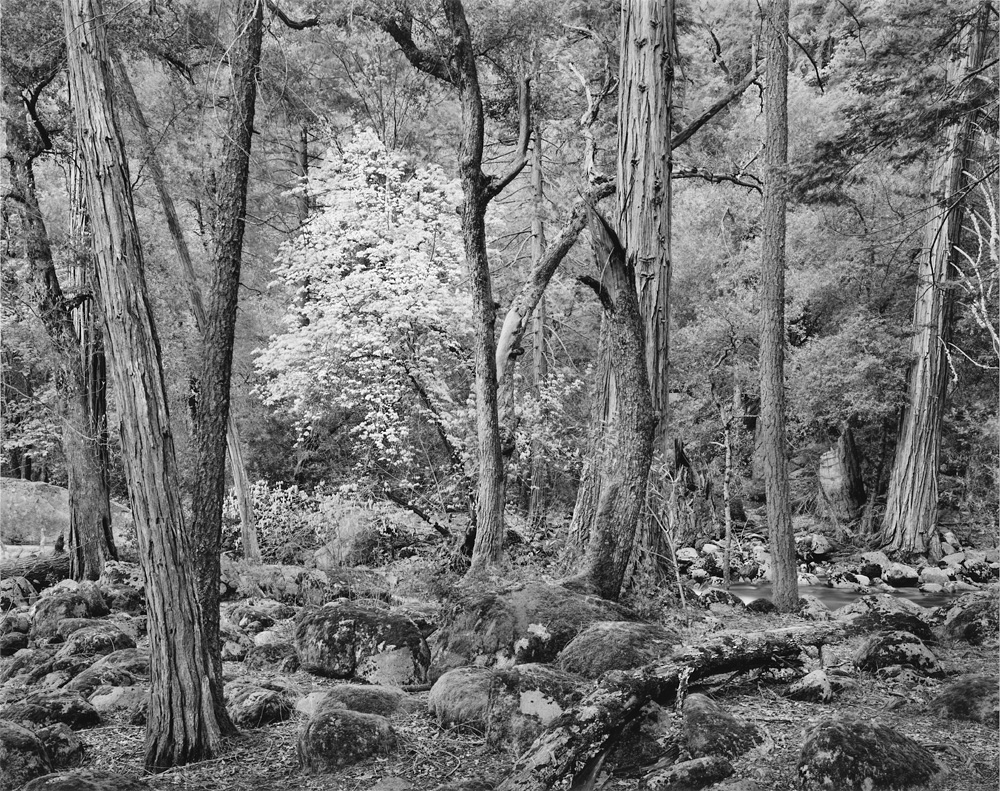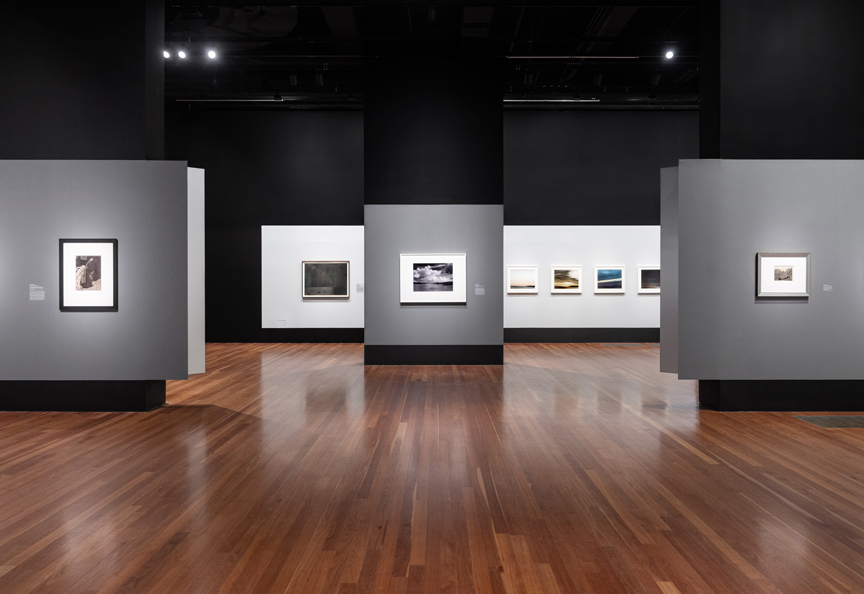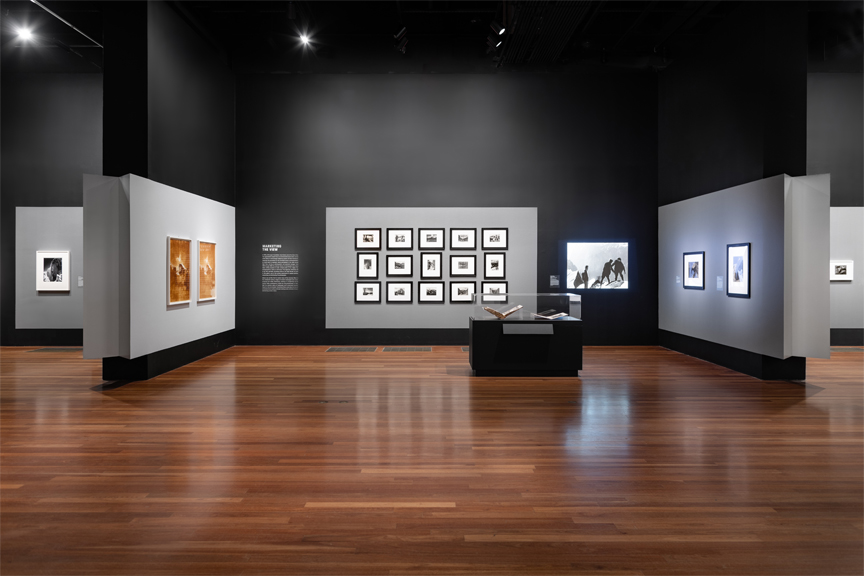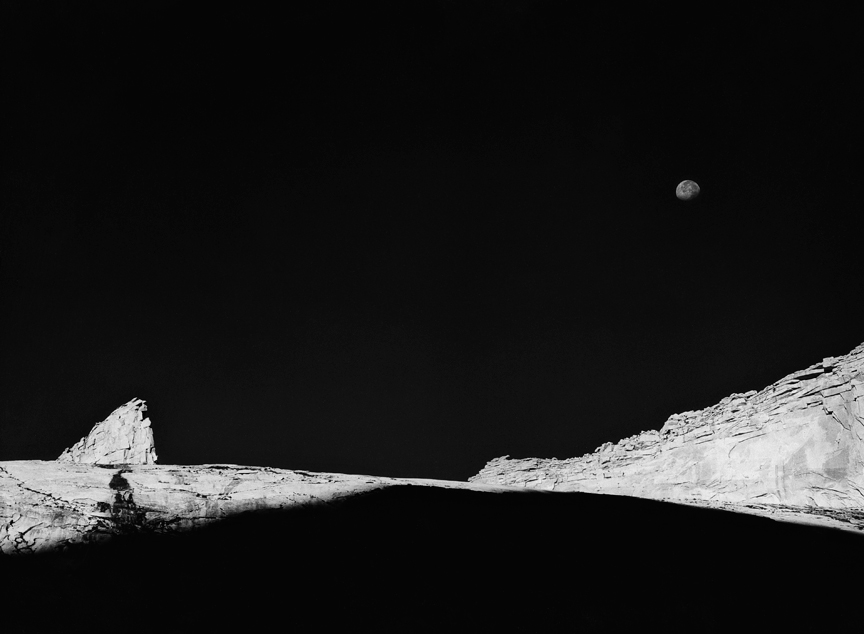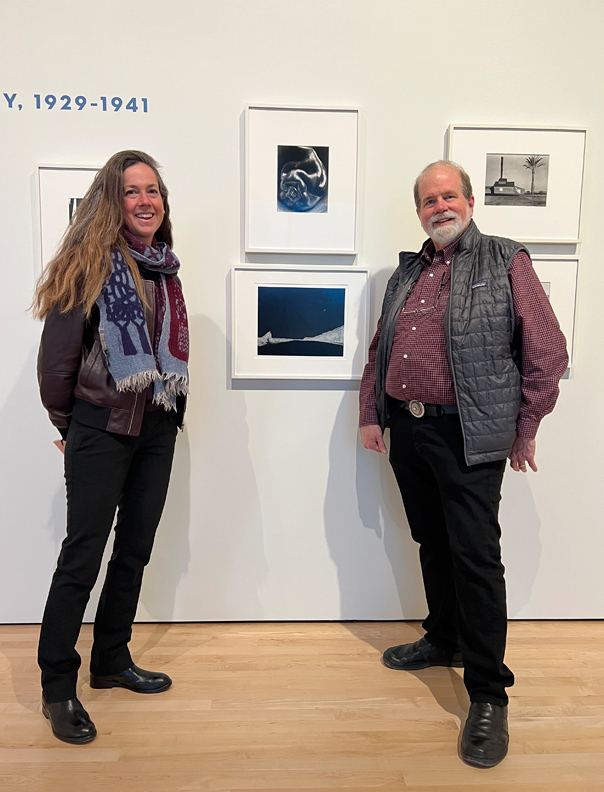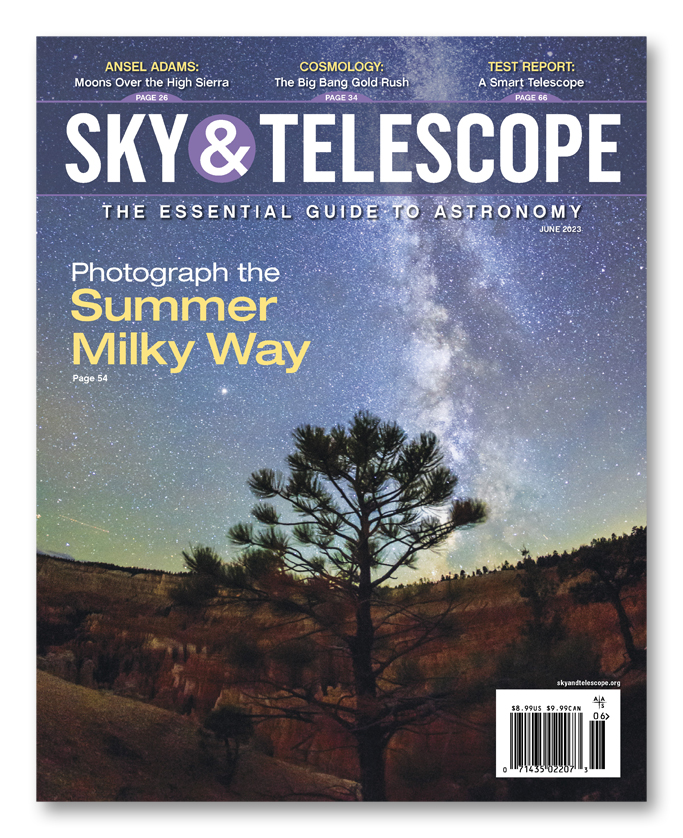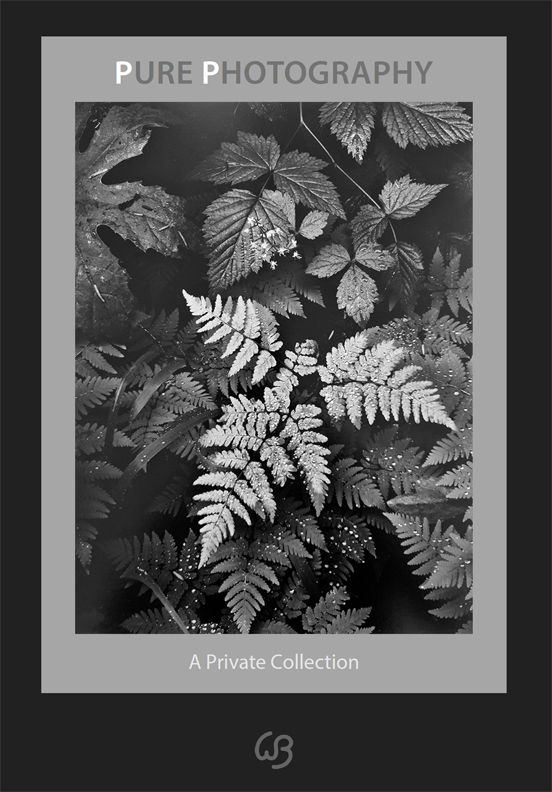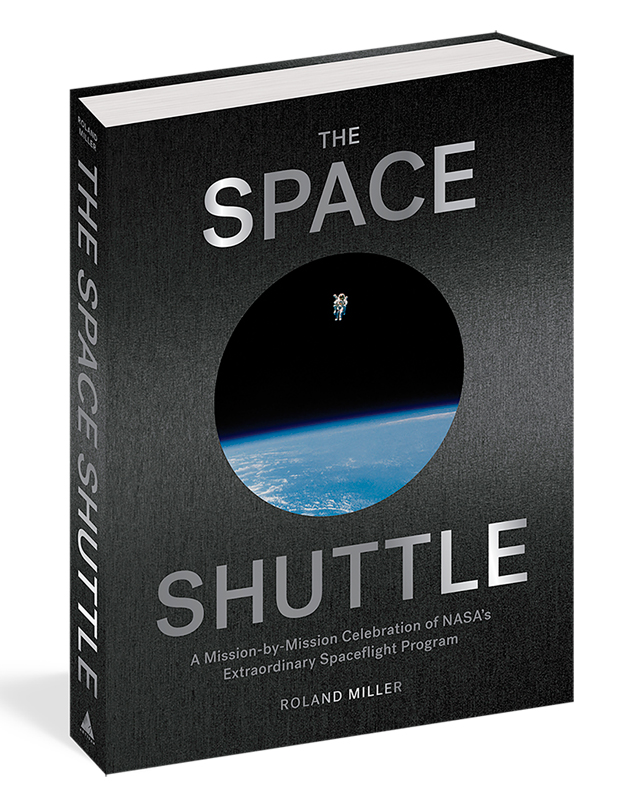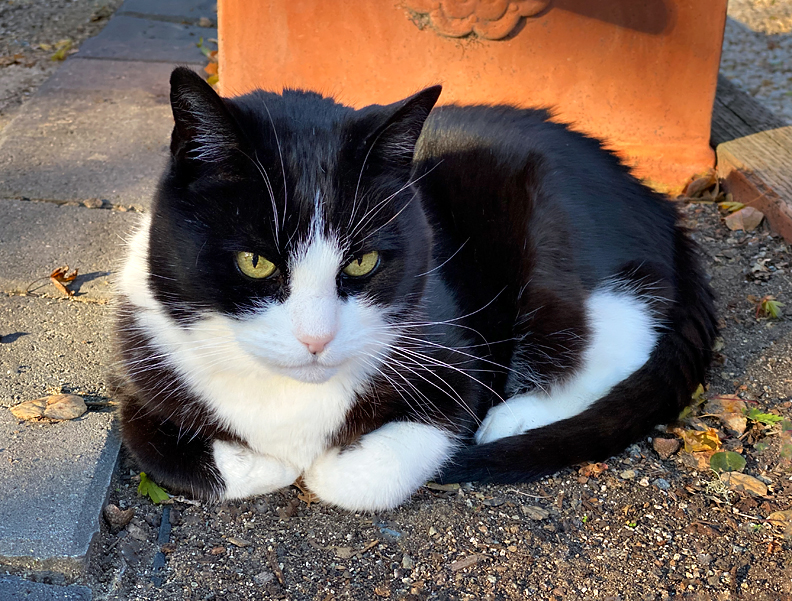It is almost impossible for me to imagine that my life, and my photography, was transformed almost exactly 50 years ago - that's a half century! Due to a completely unplanned, and unexpected, convergence of occurrences, my youthful dreams about photography, and the subsequent life I would live, were thrown into chaos. These resulted in an outcome that was beyond anything I could comprehend or imagine at the time. Looking back over the fortunate experiences I have had during the past five decades, had I set goals at the time, they would have been far more modest than good fortune bestowed upon me.
I was in my second year as a photography major at Cypress College. As I looked forward with youthful eyes, I imagined the opportunity of being a commercial photographer. My favorite photography instructor, David F. Drake, had been a photographer for North American Aviation (today Boeing Corporation), and his stories and images inspired me to desire a similar career. It was at the end of February 1973 when events beyond my control, and certainly beyond my comprehension at the time, began to unfold...
My good friend, and fellow photography major, John Charles Woods, began to unravel the mysteries of Ansel Adams' 'Zone System' for me, and I started to explore the possibilities of large format landscape photography with his help. During these early photographic explorations, I worked with a rather unwieldy 4x5" monorail view camera, lens, and tripod that belonged to the photography department.
A few weeks later our photography professor, David Drake, encouraged our entire Technical Photography class to visit an exhibition of photographs—Master Photographers: Ansel Adams, Wynn Bullock, and Edward Weston—at the Pasadena Museum of Art, (today, the Norton Simon Museum) in Pasadena, California. Each student was required to write a report on the exhibition. I had never been to a photography exhibition before (other than a display of student photographs at the Los Angeles County Fair), and I was stunned and mesmerized by the images I saw. I had never seen anything quite as beautiful and moving as these spectacular original silver prints. It was the first time that I experienced a photographic print bringing tears to my eyes. Attending that exhibition changed my ideas about photography, as well as my life, and that is not an understatement.
John Woods and I learned that Ansel Adams was presenting a lecture in Southern California - which we attended. The day of the lecture, I visited a photography supply retailer and purchased my first Ansel Adams book, The Negative. When Woods and I arrived at the lecture venue, Ansel Adams was at the front of the auditorium completely alone. Ansel knew John Woods and recognized him and motioned for us to join him in the front of the auditorium. Woods introduced me to Ansel, and the two of us engaged in a lively conversation with him. He was kind enough to autograph my copy of The Negative.
We both applied for Ansel's upcoming annual Yosemite workshop, and we were thrilled to be accepted. In those days, the workshop was a full two weeks in length and the tuition was a whopping $300. I was fortunate enough to receive a photography department "scholarship" to offset a portion of the tuition.
Woods and I decided to camp during the two-week event, as we were both low on funds. The workshop experience exceeded my expectations in every way. I had hoped that I would learn a lot about photography during the workshop, and thought that attending such a workshop would be good for my photographic resume. I had no idea that my eyes, my mind, and my heart would be opened to so many new ideas during those days in Yosemite. Ansel impressed me, along with the rest of the instructors on the staff, the assistants, and the other participants in the workshop. There was a synergy of positive creative energy in the group that was enhanced by the embrace of the cliffs of magical Yosemite Valley.
I returned from that workshop experience energized, excited, and motivated beyond my wildest expectations. My passion for photography had been ignited during those months 50 years ago, and I am pleased to say that it still burns intensely today.
I would not have the opportunity to share my photographs and my writings with you - my loyal eNewsletter subscribers - had these experiences not transpired 50 years ago. I am humbled by those of you that are interested in my photography and am most grateful for the opportunity to communicate to you through my images and my words.
I hope that you will find a glimmer of interest and inspiration in this edition of my eNewsletter and in the photographs that I am sharing with you.
Cheers!
John
P.S. As unwanted emails continue to grow in number and frequency, it is a challenge for us to try and make sure our eNewsletters successfully reach our subscribers. I have a more difficult time than some–thanks to my last name!
Please help us reach you by making sure you have your spam filters and email software set to accept info@johnsexton.com, and be sure to let us know if you change your email address. Thanks!
ORIGINAL SILVER GELATIN PRINT BY JOHN
AVAILABLE ONLINE AT DISCOUNTED PRICE
I am pleased to offer a handmade silver gelatin print of my image Forest in Spring, Happy Isles, Yosemite Valley, California at a special reduced price at the Ventana Editions online store. It has been more than a decade since I last printed this negative. It may come as a surprise, but this is one of my most challenging negatives to print. The image relies on a subtleness of tone, and much of the pallet is middle gray. Images that have bold contrasts of black and white can often tolerate a greater variability than those with more subtle values. As always, I wanted to get things just right, and with this image it took much more time and effort than with some. Please don't feel as if I am complaining or asking for sympathy. The fact is, that I am extremely pleased with these new prints made on Ilford Multigrade Classic paper. Due to the amount of very fine detail in this image, it is a greater challenge than usual to accurately convey the subtlety of tone in the original print as you view this on your electronic device.
Once I have fulfilled all the orders for this special print offer the negative will be retired and will never be printed in any size as a silver gelatin print in the future. The normal gallery retail price for this 11x14" print is $1,500. From now through June 15, 2023, I am offering this 11x14" print for $900 - a 40% discount from the retail price. On June 16, 2023, the retail price for any remaining prints will increase to $2,500.
Forest in Spring, Happy Isles, Yosemite Valley, California
©1989 John Sexton. All rights reserved.
To learn more about the print, Forest in Spring, or to place an order, follow this link:
https://ventanaeditions.stores.yahoo.net/foinsphaisyo.html
Springtime in Yosemite can be a wonderful rejuvenating experience. After this past winter's massive snowfall in the high country, the Merced River is now rushing, the glorious waterfalls are roaring, and creeks flowing vigorously. This photograph, Forest in Spring, Happy Isles, Yosemite Valley, California was made in April 1989 just over 34 years ago. I was conducting an annual week-long photography workshop with my teaching partners, Bruce Barnbaum and Ray McSavaney. We selected mid to late April each year as an optimum time for photography. This particular year I arrived a few days prior to the start of the workshop as I was doing some film testing for Eastman Kodak at the time. One of my favorite areas of Yosemite Valley has always been Happy Isles, and I went there on multiple occasions prior to the start of the workshop. For the most part, there were only green buds of leaves on the deciduous trees in that part of the Valley.
When leading field sessions during workshops, I have always felt that my job was to assist workshop participants with their own photography in any way that I could. Such was the case this day. We took the entire group to Happy Isles for the afternoon and into the evening. The three of us announced our locations and workshop students were encouraged to head off with one of us so we could work together in smaller groups. As I remember, Bruce Barnbaum led a vigorous hike up to the top of Vernal Fall. Ray was working along the Merced River, not far from one of my favorite locations where this photograph was made. After interacting with each of the workshop participants and looking through their cameras, offering constructive commentary when appropriate, I found that everyone seemed to be working smoothly on their own. I began exploring with my viewing frame trying to arrange a scene that I had studied a few days earlier. Since then, the small green buds had erupted into a verdant lime green "bouquet" of fresh leaves. Earlier in the afternoon, this scene had been visually "busy" due to the direct sunlight. As the sun dropped behind Glacier Point—some 3,000 feet above me—a soft light bathed the forest, giving it a glow and simplicity that I found appealing. In addition, there were huge billowy clouds above still illuminated by direct sunlight bouncing a soft directional quality of light that I found irresistible.
As I pondered the possibilities with my viewing frame, simulating different focal length lenses, I was surprised when I decided on my camera position and the use of my 75mm wide angle lens - the widest lens I owned for my 4x5 view camera at the time. I wanted to try and create an image that would invite the viewer into the scene rather than observing the scene from a distance. The camera position was very critical. An inch to the left or a small distance to the right created visual challenges. I wanted the trees to appear tall, so I chose a lower camera position. Over the years, having shown this photograph to a number of people, most viewers do not sense that it was made with a wide-angle lens. Partly this is because I very carefully leveled the camera when setting it up, but honestly it was simply good fortune. The tree trunks and limbs that were closest to the camera were somewhat diminutive in size. Their size was exaggerated by their proximity to the wide-angle lens. Most of the tree trunks in the distance were huge, so there was a "normalization" of scale that occurred that was totally beyond my control.
A couple of nearby workshop participants had noticed me setting up my 4x5 view camera and came over to see what had attracted my interest. I explained that I wanted to lighten the lime green fresh leaves of one specific tree just left of center in my planned image. I discussed my decision-making process with them. I said that I thought a green filter would lighten them most effectively, and I made two identical negatives with my Wratten #11 green filter. I then decided to look through my Wratten #8 yellow filter as a comparison. To my surprise, it appeared as if the yellow filter might lighten the leaves even more, so I made two additional identical exposures with that filter. It was only when I made the contact sheet of all four negatives that I could see that indeed the unlikely yellow filter candidate had produced an image that was closer to my visualization. I made careful notes in the field at the time so that I could learn from this experience. Since then, when working in the spring in that portion of Yosemite Valley with fresh green leaves, I reach for my yellow filter with confidence.
If you haven't visited Yosemite in the spring, I encourage you to do so. It is amazing how quickly the valley changes as new life literally explodes from the quiet season of winter in advance of the warmth of summer.
Prints will begin shipping on May 4, 2023. All the remaining prints ordered will be shipped no later than September 30, 2023.
This silver gelatin, selenium toned, print is approximately 13 x 10-5/16", personally printed by me (as are all my prints), processed to current archival standards, signed, mounted, and matted to 16x20" on 100 percent rag museum board.
All prints are carefully prepared and packaged in specially designed protective shipping boxes, and shipped fully insured via UPS ground. If you have any questions about the prints, please feel free to contact Anne at 831-659-3130, or email: info@johnsexton.com. Our office hours are Monday through Thursday from 10:00 am to 1:00 pm, Pacific Time.
You can see the image and place a secure online order for the print at the Ventana Editions web store.
ANSEL ADAMS IN OUR TIME
EXHIBITION AT THE DE YOUNG MUSEUM, SAN FRANCISCO
THROUGH JULY 23, 2023
Anne and I had the great pleasure to attend a special reception for the recently opened Ansel Adams in Our Time exhibition at the de Young Museum in San Francisco. We were thrilled to be invited to attend this celebration of Ansel's photography which is complimented by interesting 19th century historical photographs, as well as images by 23 contemporary photographers. We had the opportunity to visit with several of Ansel's family members, trustees of The Ansel Adams Publishing Rights Trust, museum staff, as well as a number of photography friends.
This exhibition, which includes more than 100 of Ansel's prints, is Ansel's fifth major show at the de Young! One of Ansel's first important exhibitions was at the de Young in 1932. That was followed by another exhibition in 1935, and a huge exhibition—sixty years ago—in 1963. Ansel had a posthumous retrospective exhibition at de Young in 1987, Ansel Adams: One With Beauty which had an attendance of over 200,000 visitors! Ansel Adams in Our Time, which will be on display through July 23, 2023, was organized and curated by Karen Haas, the Lane Curator of Photographs, at the Museum of Fine Arts, Boston. Nearly all the Adams prints in this exhibit are from the Lane Collection—a massive gift to the MFA that included more than 6,000 photographs. The original exhibition opened at the MFA in late 2018 and was a huge success. It has been shown at the Crystal Bridges Museum of American Art as well as the Portland Art Museum before this special exhibition at the de Young Museum. This current iteration includes prints from the de Young's permanent collection. Also on display are prints from a handful of 19th century photographers, including John K. Hillers and Carlton E. Watkins, as well as contemporary photographers, including Binh Danh, Chris McCaw, Laura McPhee, Richard Misrach, and my longtime friends, Lois Conner, and Mark Klett.
Anne and I both love the de Young Museum. It is just a wonderful place to visit. The de Young is a stunning piece of architecture in the beautiful setting of Golden Gate Park. If you decide to attend Ansel Adams in Our Time be sure to plan enough time to visit other areas of the museum.
The installation of this exhibition is tasteful and dramatic. The high ceilings and the spacious galleries, with walls in various shades of gray, give the prints a wonderful opportunity to speak to the viewer. Ansel would love that—he strongly disliked white walls for the display of photographs! See if you can figure out the meaning of the different shades of gray (Zones!) of the wall panels! Along with insightful wall text panels, there are video presentations that complement the photographs. I am confident that most people that attend the exhibition will find the variety of photographic approaches of interest, and even dedicated Ansel Adams "fans" will likely see one or more prints that they have not previously seen—which is always a treat!
This is bound to be an extremely popular exhibition, so you will need to plan and purchase tickets in advance—as this exhibition has timed entrance. Tickets do include access to all permanent collection galleries at the de Young. While you are there, be sure to visit the Piazzoni Murals Room where you will find panels painted by Ansel's friend, Gottardo Piazzoni in 1931-32. Visiting the room is a wonderful experience. Ansel included a portrait of Gottardo in his Portfolio VI which he dedicated to Piazzoni and Edward Weston.
Enjoy!
ANSEL ADAMS PHOTOGRAPHS
SLEUTHING EXACT DATES AND LOCATIONS
PHOTOGRAPHY EXHIBITION—CANTOR ARTS CENTER, STANFORD UNIVERSITY
About a year ago, I received an unexpected email from my longtime friend, and former colleague at Ansel's, Mary Alinder. She was helping Dr. Kim Beil, an art historian and teacher at Stanford University who specializes in the history of photography. Kim had developed a keen interest in a lesser-known Ansel Adams photograph, High Country Crags and Moon, Sunrise, Kings Canyon National Park. This photograph had captured Kim's attention as she was working with Josie R. Johnson—a curator at the Cantor Center for the Visual Arts—on an upcoming,at the time, exhibition and publication—Reality Makes them Dream: American Photography, 1929-1941. Kim was fascinated by the fact that Ansel did not provide a precise date as to when he made this image. As is the case with quite a few of Ansel's images High Country Crags and Moon carried the word 'circa' in front of the estimated year of 1935.
Mary wondered if I had a familiarity with this specific image, and if I could provide any addition details about it. Interestingly, I vividly remember this image as it was the negative that Ansel put into his enlarger the day before I began working as his technical and photographic assistant in 1979. He was just beginning to make prints for the largest printing project of his entire life—the Museum Set. I was happy to contribute whatever information I might be able to provide. Little did I know at that time how much I would learn about this 3-1/4 x 4-1/4" negative, and how and when Ansel made this photograph.
I believe I can safely say that Kim had become obsessed with this image, and she was determined to try and find out a verifiable date for the making of the photograph. Ansel has many images where the date included in exhibitions and publications is preceded by 'c.' or 'circa.' In a memo from Ansel that was on my desk when I arrived for my first day of work, he wrote, "I have a poor memory for names, dates, etc." I remember Ansel making statements along these lines of, "Circa is one of my favorite words as it covers a multitude of sins!"
High Country Crags and Moon, Sunrise, Kings Canyon National Park, California
Ansel Adams
©The Ansel Adams Publishing Rights Trust. All rights reserved.
When I joined the email communications Kim was working with Donald Olson, professor emeritus of physics and astronomy at Texas State University, and had already done considerable research into determining the location where the photograph was made. Don had been involved in the precise dating of several Ansel's photographs using his astronomical skills as a self-described "Celestial Sleuth." I had communicated with Don providing information for some of his past Ansel dating projects. I learned that Kim had planned a backpacking trip to the High Sierra in September and, with Don's guidance and expertise, hoped to be able to generate photographic, as well as GPS, data to enable Don and his team to determine the precise location, date, and time that Ansel made his exposure.
I was able to identify the format of the negative based upon Ansel's negative file number. Initially, a thought was proposed that Ansel used a Zeiss Miroflex camera. He had used this camera for a number of his early images, and that seemed like a good possibility. As I began to investigate further, and Don provided historic Zeiss literature, I realized that the camera Ansel would have used on that trip was his new to him at the time, Zeiss Juwel camera. He had been provided this camera, along with a highly prized Double Protar lens, by Zeiss just a few months before he made the photograph.
Ansel excitedly wrote to his wife Virginia from New York City in January of that year:
"...Have made a wonderful contact with Zeiss. Dr. Bauer the head of the U.S. Branch has been more than kind. I emerge with another lens for the Contax, a new case, a new developing tank, AND, believe it or not, a Zeiss "Juwell" [sic] 3-1⁄4 x 4-1⁄4 with a real Zeiss Double Protar lens. It's the best in the world...."
Rather than trying to describe this project myself, I want to direct you to Kim Beil's wonderful account of her fascination with this specific Ansel Adams photograph, the research that she did, and the backpacking adventure that she and her husband, Patrick Turner, took last September. Her article, When the Light, Shadow and Stars Aligned: Standing Where Ansel Adams Stood, was published in The New York Times on March 13, 2023. Kim has kindly provided a link to that article (which is not behind a paywall!). I think you will find her story to be most interesting, and informative.
Kim Beil and John Sexton
with Ansel Adams print
High Country Crags and Moon, Sunrise
Opening Reception at the Cantor Arts Center, Stanford University
Reality Makes them Dream: American Photography, 1929-1941
©2023 Anne Larsen. All rights reserved.
The exhibition that includes Ansel's High Country Crags and Moon print—Reality Makes them Dream: American Photography, 1929-1941, is on display at the Cantor Arts Center at Stanford University through July 30, 2023. This exhibition of over 100 photographs, periodicals, and books offers an alternative understanding of photography from 1929-1941. The core body of work in the exhibit comes from the Capital Group Foundation Photography Collection at Stanford University. Along with six prints by Ansel, there are photographs by many legendary photographers of the time including Bernice Abbot, Ruth Bernhard, Margaret Bourke-White, Imogen Cunningham, Walker Evans, John Gutmann, Dorothea Lange, Helen Levitt, Barbara Morgan, Gordon Parks, Edward Weston, and more. Anne and I particularly enjoyed seeing beautiful prints by Wright Morris, Marion Post Wolcott, and Seema Weatherwax (an early assistant to Ansel).
The exhibition at the Cantor Arts Center is open Wednesday through Sunday from 11:00 AM to 5:00 PM. The exhibition is free and open to the public but reservations are suggested. Follow this link to get additional information about reservations as well as parking at Stanford University, as well as access a virtual tour of the exhibition.
Now back to Don - the self-described Celestial Sleuth...
Don just published a very detailed, and most interesting article, Ansel Adams and Moons Over the High Sierra, in the just released digital and print editions of Sky & Telescope magazine with a cover date June 2023. In this article Don describes 'how the sausage was made' in determining the exact location, date, and time of the making of Ansel's High Country Crags and Moon photograph, but also for Ansel's image Dawn, Mount Whitney, Sierra Nevada, California. Here is a brief description about the article from Don:
"Our Texas State University group has long been inspired by the work of Sky & Telescope editor Dennis di Cicco, who used a site visit and astronomical analysis to establish the correct date for Ansel Adams' photograph, Moonrise, Hernandez, New Mexico. Our past articles used similar methods to determine precise locations, dates, and times for five more photographs by Ansel Adams: Moon and Half Dome; the color and black & white versions of Autumn Moon; Moon and Denali; and Denali and Wonder Lake.
The opportunity recently arose to extend this type of analysis to two photographs from the early days of Ansel Adams's career. High Country Crags and Moon, Sunrise, Kings Canyon National Park, California includes a waning gibbous Moon sinking toward the horizon to the southwest. Dawn, Mount Whitney, Sierra Nevada, California includes a waning crescent Moon high in the eastern sky. For both of these images, our analysis was able to determine a precise tripod location, date, and time. With expert assistance from Mary Street Alinder and John Sexton, we also determined the camera and lens combinations employed.
Our analysis incorporated topographic maps, satellite images, modern photographs taken both by day and by night at the sites (by Stanford art historian Kim Beil in Kings Canyon N.P. and by several hikers and climbers near the summit of Mount Whitney), biographical material in the Ansel Adams archives, chronicles of the summer High Trips published in vintage numbers of the Sierra Club Bulletin, and astronomical calculations of lunar surface features, phases and positions during the 1920s and 1930s."
It was a blast to be able to play a small part in the sleuthing into two of Ansel's photographs. In checking my notes from 1979, I found that my memory was quite accurate about some things, but really sucked when it came to other details. I am beginning to think that I should use 'circa' more often going forward!!!
Oh, by the way, Ansel made High Country Crags and Moon with the 29 cm component of his Zeiss Protar lens on his Zeiss Juwel 3-1/4 x 4/1/4 camera at 6:47 a.m. on Aug. 6, 1936. The early photographer gets the sunrise photograph! I guess that's why I like making photographs in the quiet light of dusk!
JOHN'S PHOTOGRAPHS INCLUDED IN EXHIBITION
WBB GALLERY—ZURICH, SWITZERLAND
I am humbled, and honored, to have five of my photographs in the recently opened Pure Photography exhibition at WBB Gallery in Zurich, Switzerland. The exhibition will be on display through August 27, 2023. The exhibition includes 54 silver gelatin prints from 18 American photographers.
This group of photographers includes a number of icons in the world of photography—several of whom I had the opportunity to call friends, mentors, colleagues, and workshop co-instructors. The photographers in "Pure Photography" are Ansel Adams, Morley Baer, Wynn Bullock, Robert Byers, Paul Caponigro, Walter Chappell, Imogen Cunningham, Henry Gilpin, Bob Kolbrener, Roman Loranc, Michael Miner, Ryuijie, Willard Van Dyke, Brett Weston, Edward Weston, Minor White, Don Worth, and me.
Leaves, Mt. Rainier National Park, Washington
Ansel Adams
©The Ansel Adams Publishing Rights Trust. All rights reserved.
You can find additional information about the "Pure Photography" exhibition, as well as a video overview of some of the images in the exhibition, at the WBB Gallery website.
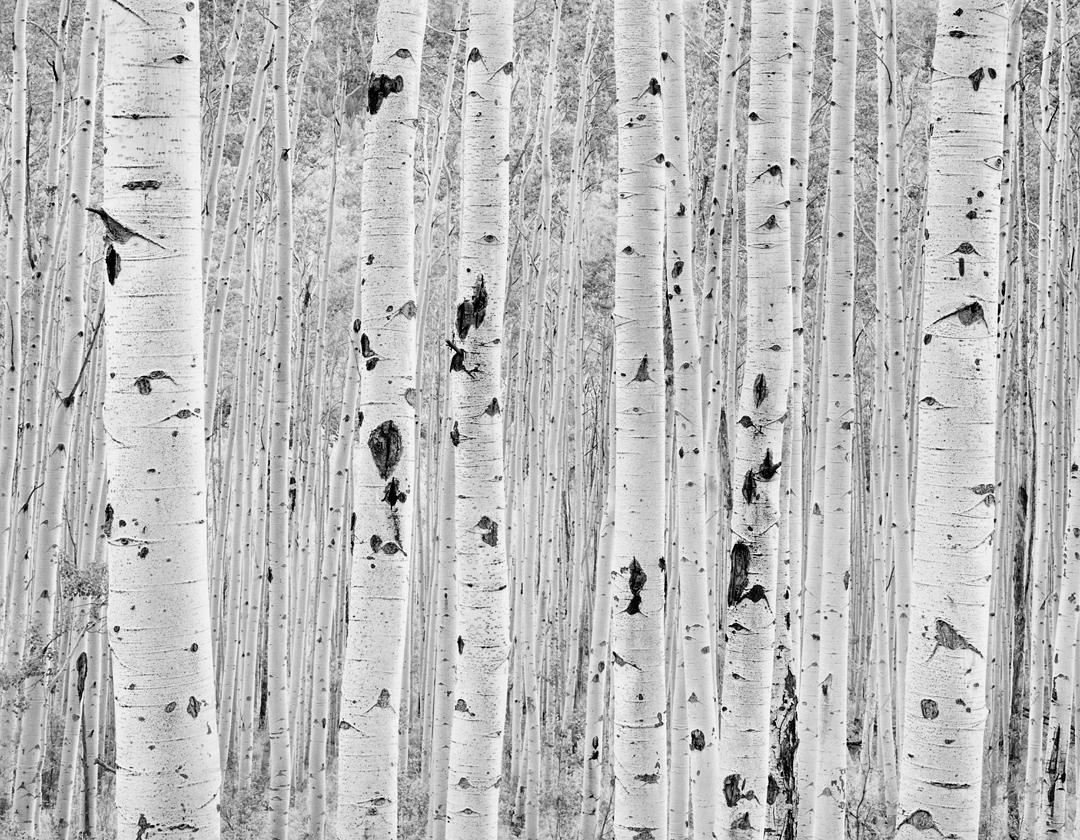
Aspen Quiet Light, near Aspen, Colorado
©1989 John Sexton. All rights reserved.
Along with having my work in the exhibition at WBB Gallery in Zurich, I am also pleased to be included in a special exhibition WBB Gallery will be presenting at Photo Basel—one of the leading fine art photography fairs in Europe.
JOHN'S PHOTOGRAPH INCLUDED IN
THE SPACE SHUTTLE
BOOK BY ROLAND MILLER
I am delighted to have my photograph Atlantis from Above, Vehicle Assembly Building, Kennedy Space Center, Florida. Included in the recently published book The Space Shuttle: A Mission-by-Mission Celebration of NASA's Extraordinary Spaceflight Program by Roland Miller.
I first met Roland in the 1990s during one of my thirteen week-long visits to the Kennedy Space Center in Florida while I was working on my Space Shuttle photography project. At the time, Roland was a photography instructor at Brevard Community College (now Eastern Florida State College). Along with being a gifted educator for decades, he is also a most talented photographer. We spent a day photographing together at Cape Canaveral Air Force Station while Roland was working on his Abandoned in Place photographic project. His book, of the same title, is a real beauty.
In 2021 I received an unexpected email from Roland asking if he could use one of my Space Shuttle images in a book he was working on. I gladly agreed to his request. Roland very kindly, and professionally, gave me periodic updates as the book evolved. I had no preconceived ideas about the book.
When my copy of the book arrived, I was stunned. The book exceeded my expectations in every way! As is typically the case, the first thing I do when I receive a publication is to find my image to see how the reproduction quality, cropping, credit etc. were executed.
With this book I was stopped in my tracks by the elegant, and cleverly designed, slipcase with a round cutout opening that reveals a portion of the book cover. In the cutout is a tiny astronaut floating in the blackness of space above a pale blue horizon. Removing the book from the slipcase, the untethered floating astronaut, Bruce McCandless II, seems even smaller, space blacker and much larger, as our blue planet is revealed below.
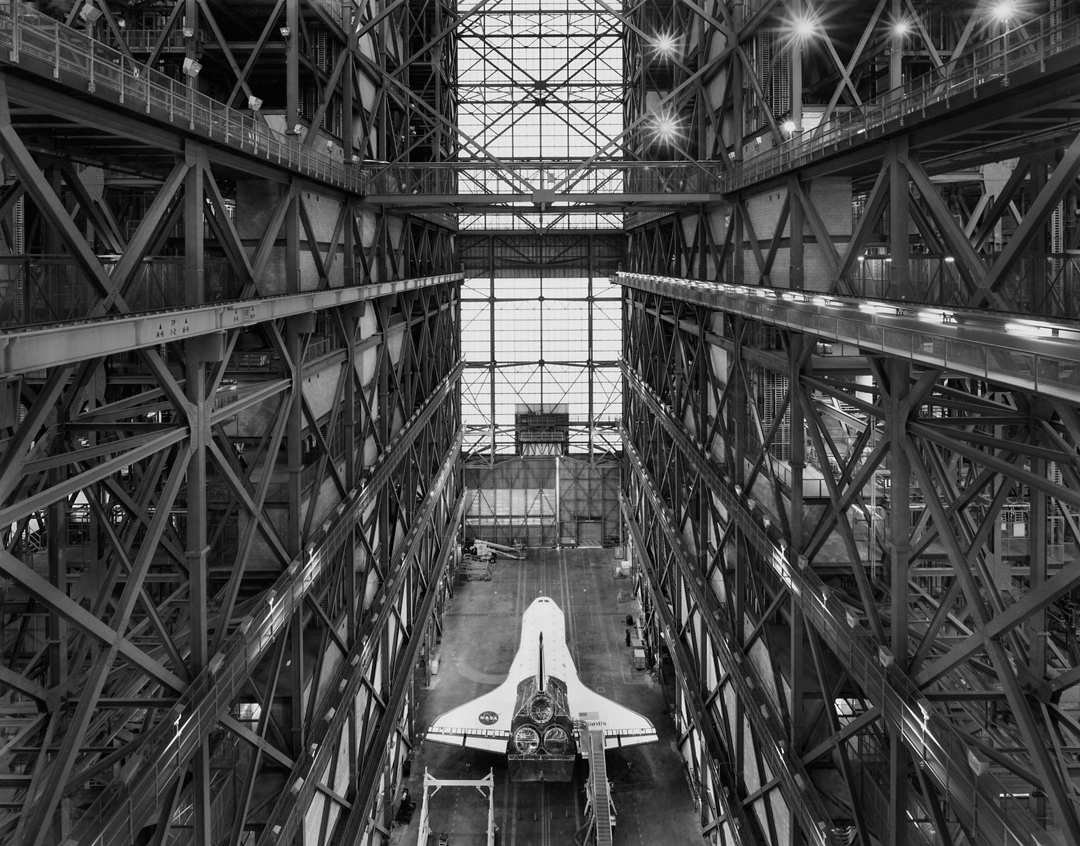
Atlantis from Above, Vehicle Assembly Building, Kennedy Space Center, Florida
©1999 John Sexton. All rights reserved.
When I finally got to my image—which did not take long because it is included in Roland's introduction to the book. I was pleased with the reproduction quality, and even more pleased with Roland's kind words...
"Some photographers' images express an idea or viewpoint that is unusual or exceptional. John Sexton photographed the Space Shuttle program during the 1990s. His image Atlantis from Above, Vehicle Assembly Building, part of a larger body of work entitled Places of Power, shows the Space Shuttle Atlantis parked in the Vehicle Assembly Building's transfer aisle. Atlantis appears small when viewed from an upper level of the Vehicle Assembly Building until one remembers that it is the size of a Boeing 737 aircraft. The image pays tribute not only to Atlantis but also to the architecture of the building. The scale of the orbiter gives insight into the scale of the building, a marvel of technology itself."
The photographs - many made by Space Shuttle astronauts - are dramatic and beautiful. The book is sequenced chronologically from the earliest test flight to Atlantis' last journey and the end of the Space Shuttle program in 2011. The back cover has an interesting extremely brief overview summary of the Space Shuttle program.
6 Orbiters
140 Missions
355 Astronauts
500,000,000 Miles
LEARNING TO SPEAK NASA
A LANGUAGE OF ACRONYMS AND ABBREVIATIONS
I made my first trip to photograph at the Kennedy Space Center in Florida in March 1993—just over thirty years ago. I had spent more than two years prior to that first visit attempting to get permission to have special photographic access to the Space Shuttle program. To say I was nervous when I arrived would be a gross understatement.
After clearing security at the perimeter of the 6,000 acres complex, I headed to the Press Site. I was greeted by a Public Affairs Officer, Manny Virata. Little did I know how much time Manny and I would spend together during my upcoming twelve additional visits. Unfortunately, on this day Manny was overwhelmed as they were shorthanded, and there were two foreign film crews working on documentaries. Manny was kind, and very apologetic about the situation. He arranged for me to have access to their massive photography library. With the help of Kay Grinter, the librarian, I looked through many huge notebooks filled with 8x10 photographs of the Space Shuttle and Kennedy Space Center.
Finally, after lunch Kay and I were off to the massive Vehicle Assembly Building. On the short drive there, Kay referred to it as the VAB—which made perfect sense. She then said we would need to check-in at the OPS desk—which again made sense—as the sign on the door we entered said 'Operations.' After making photographs inside the cavernous VAB, I said I would really like to see a Space Shuttle orbiter up close. Kay called over to an OPF, and we were granted permission to visit one of the Orbiter Processing Facilities.
It is hard to imagine, but a Space Shuttle orbiter is difficult to see when you enter an OPF. The orbiter is encased in movable work stands, steps, platforms, hoses, and wires. I did not realize I was standing directly beneath the orbiter until Kay pointed up and I discovered a complex mosaic of Thermal Protection tiles. I was standing directly below the belly of an OV, or Orbiter Vehicle. Specifically, this was OV-105—better known as Endeavour. My heart raced with excitement.
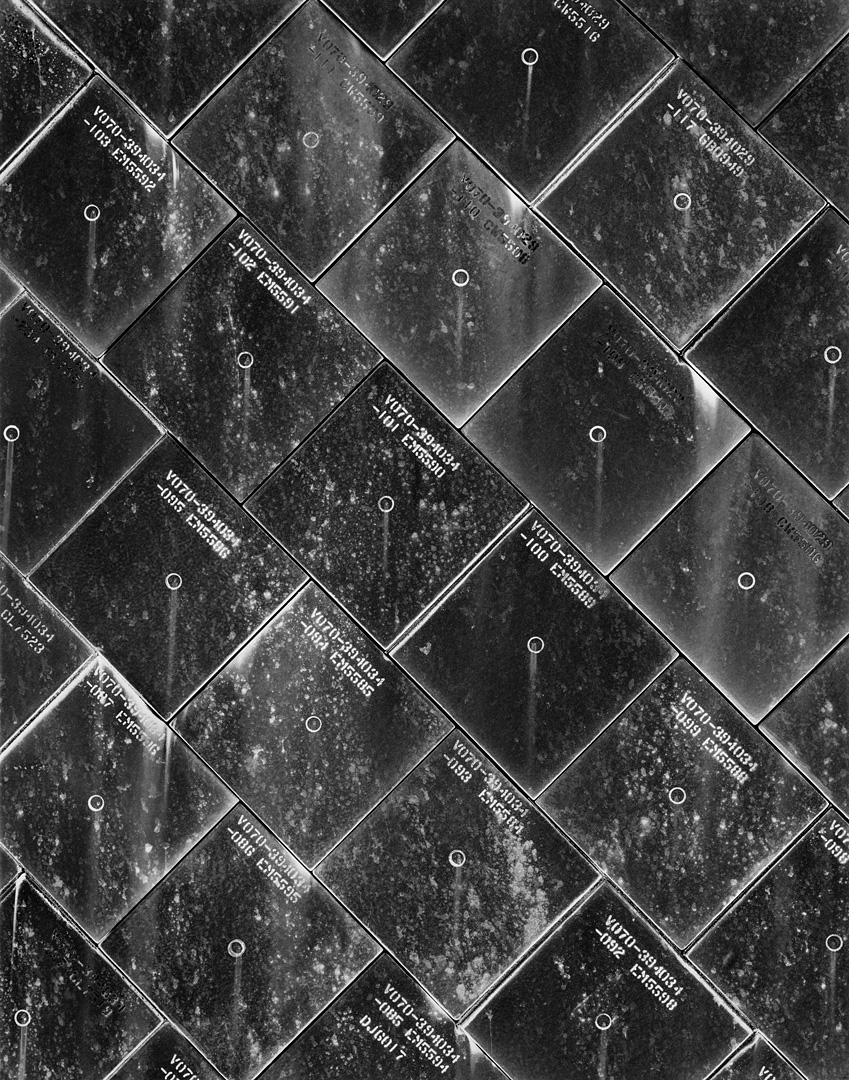
Thermal Protection System Tiles, Endeavour, Kennedy Space Center, Florida
©1993 John Sexton. All rights reserved.
I setup my 4x5 Linhof Technikardan view camera and made the first of many photographs of a Space Shuttle at KSC. I would later learn that the tiles were part of the TPS (Thermal Protection System). The tiles were made of pure silica and can withstand approximately 3,000? Fahrenheit. They protect the orbiter and its occupants during the intense heat of reentry. Each OV is covered with approximately 24,000 such tiles, each tile is approximately 6x6" in size, and has unique properties of size, shape, and thermal characteristics. Just a few weeks before I made this image of OV-105 it had been orbiting the earth at over 17,500 miles per hour.
Along with entering this new world of space flight, I entered a world with a foreign language of cryptic acronyms and abbreviations related to the Space Transportation System, or STS. As I spent time photographing at NASA's KSC I would begin to learn the meanings of ET, SRB, SSME, COMM, MLP, LCC, ISS, SLF, MCC, APU, CDR, FOD, HDQ, AOA, TAL, RTLS and may more of the approximately 9,000 acronyms and abbreviations that are part of the NASA (National Aeronautics and Space Administration) space language.
On one of my early photographic trips to KSC I was given a copy of the NASA publication, Space Transportation System and Associated Payloads: Glossary, Acronyms, and Abbreviations, by Hugh Harris the Director of Public Affairs at KSC. I found the book fascinating and most helpful.
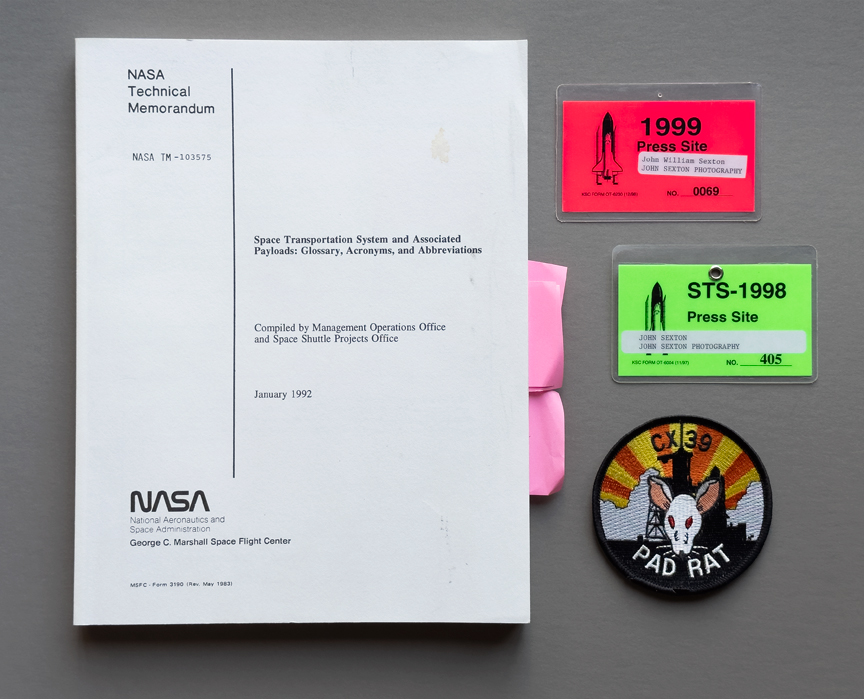
My well-used copy of NASA publication
Space Transportation System and Associated Payloads: Glossary, Acronyms, and Abbreviations
along with my two of my media security badges
and my treasured Launch Complex 39 Pad Rat patch
(very few individuals, other than KSC launch complex workers,have such a patch!)
As I worked with Public Affairs Officers (PAOs) and employees at KSC I realized I would need the help and support of many individuals. I learned two very valuable techniques to help instill interest and support in my photographic project. Sharing my photographs made during previous trips to KSC, and showing a genuine interest and respect for the important tasks that each team member contributed to the complexity of the Space Shuttle program. I found that if I understood some of NASA's space language and used appropriate terminology many folks realized that I was serious about my project. Anne would tell you I was obsessed with it!
My 208-page NASA publication, Space Transportation System and Associated Payloads: Glossary Acronyms and Abbreviations, was not only interesting to me, but it was also extremely valuable. On more than a few occasions employees would mention with surprise about my use of proper terminology. A few were even impressed! A small number of them even 'bent the rules' so that I could have super-special access to the shuttle and areas that were typically off-limits.
Along with the acronyms, the 'glossary' section has some cool references. My favorite is, "Barbecue Mode – Orbiter in slow roll for thermal conditioning." If you would like your own copy of this NASA publication you can download a PDF file.
As time went on during my nearly 3 months photographing at KSC I became more fluent in this NASA language. Had Kay then said something like this: "We're going to drive from MIPS to the VAB. We will check in with OPS, and if we get an OK, I can show you where STS vehicles are mated to the SRB's, ET, on top of the MLP right next to the SSS. Then we can go over to the OPF, and you can get a look at OV-105 and see the tiles that are part of the TPS." I think I would have understood what she meant.
I am grateful to all the kind folks that helped me with my Space Shuttle project. Without their generous support, and assistance, I would not have been able to make the photographs I did. I thank them for sharing their time, expertise, kindness, generosity, patience, and friendship. Without their efforts I would have been SOL!
IMPORTANT NOTE:
You may be relieved to know that this official U.S. Government document is clearly identified as 'UNCLASSIFIED' in case you were planning to print it out and have copies lying around on the floor, stored in your desk, or planning to share with visitors!
